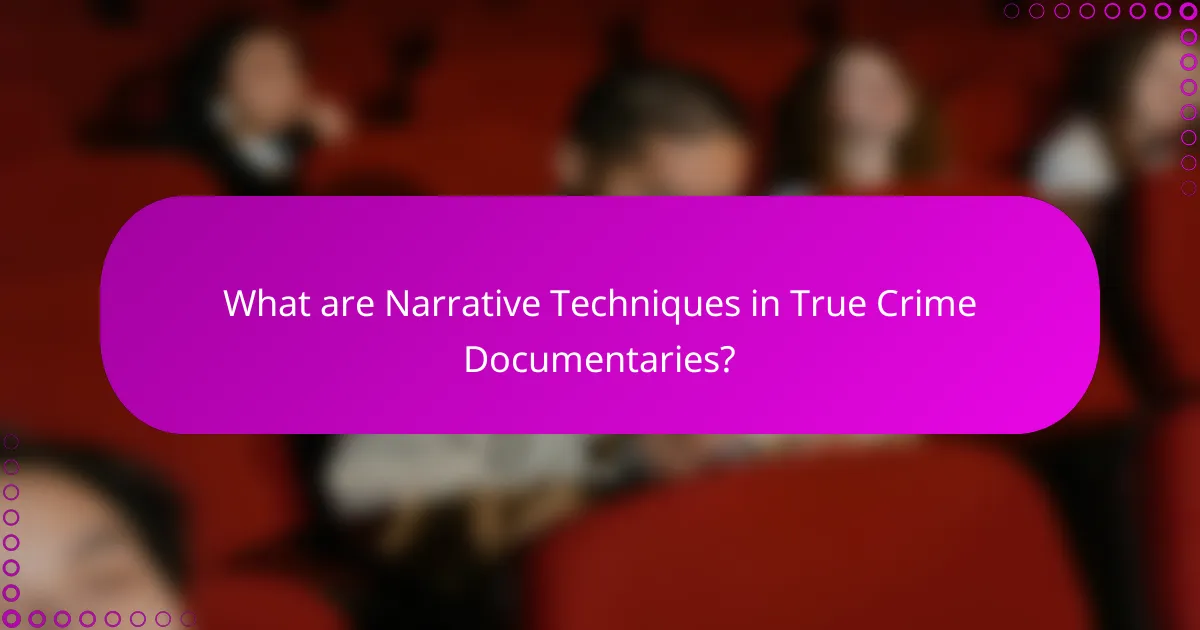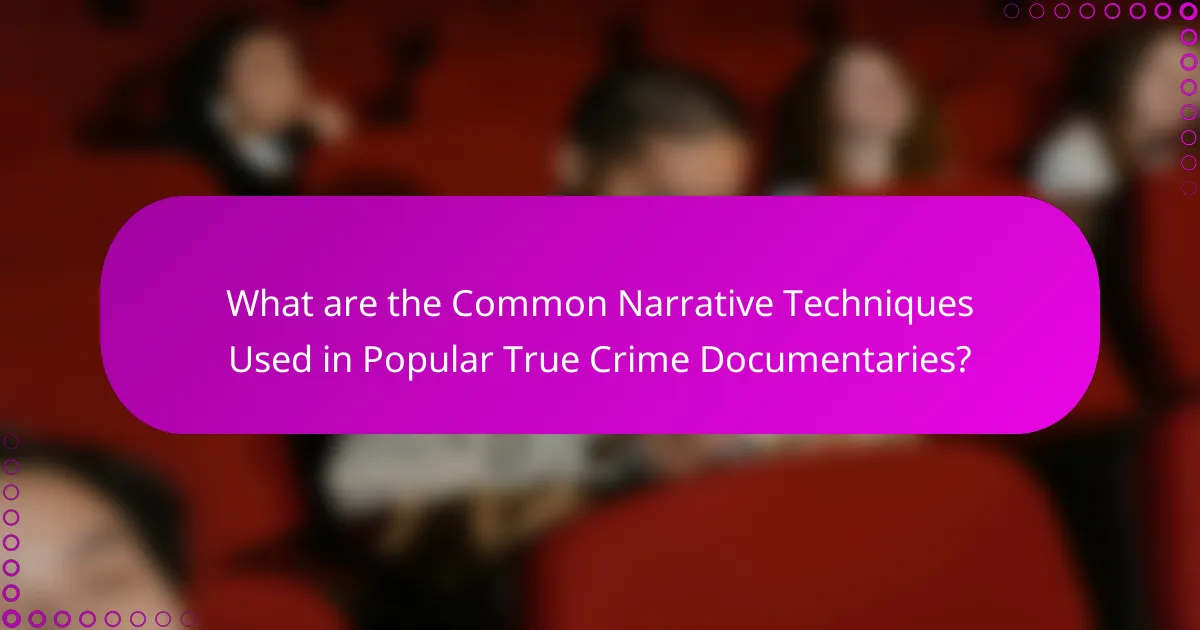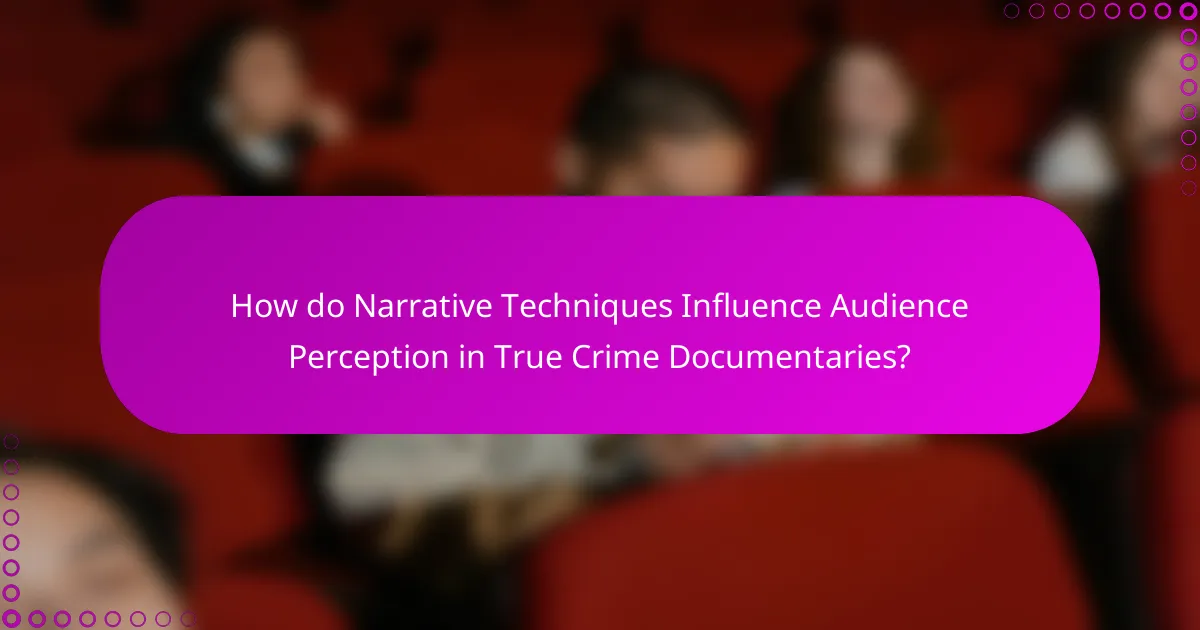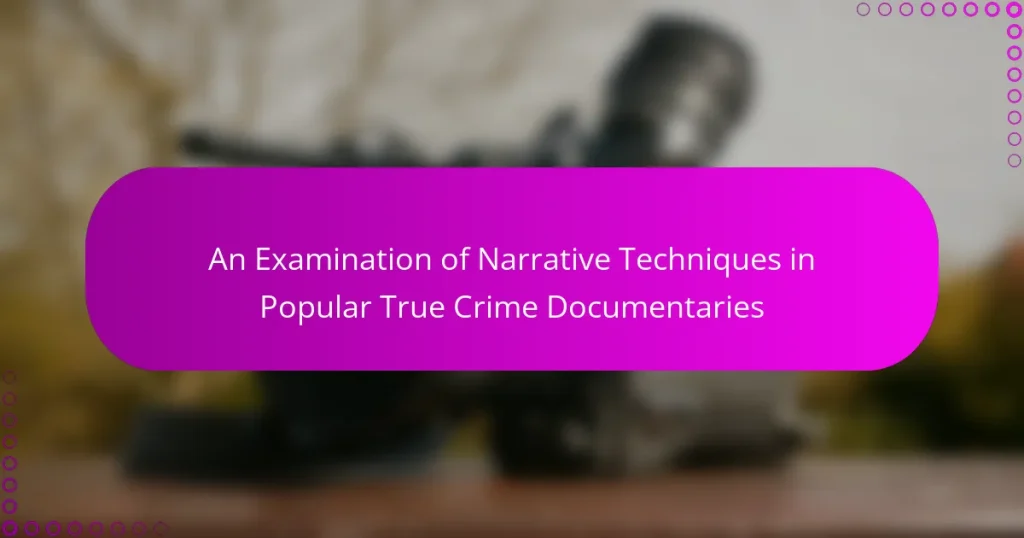This article examines narrative techniques in popular true crime documentaries, focusing on methods such as interviews, reenactments, archival footage, and voiceovers. These techniques are essential for conveying real-life criminal events and enhancing viewer engagement. Interviews provide personal insights from law enforcement, victims, and experts, while reenactments dramatize key moments to increase emotional impact. Archival footage adds authenticity and historical context, and voiceovers connect various narrative segments. The article also discusses how these storytelling methods influence audience perception, emotional engagement, and understanding of crime and its societal implications.

What are Narrative Techniques in True Crime Documentaries?
Narrative techniques in true crime documentaries are storytelling methods used to convey real-life criminal events. These techniques include interviews, reenactments, archival footage, and voiceovers. Interviews with law enforcement, victims, or experts provide personal insights. Reenactments dramatize key moments to engage viewers. Archival footage offers historical context and authenticity. Voiceovers guide the narrative and connect different segments. These techniques enhance emotional impact and viewer understanding. Research indicates that effective narrative techniques can significantly influence audience engagement and retention.
How do narrative techniques shape the viewer’s experience?
Narrative techniques shape the viewer’s experience by influencing engagement and emotional response. Techniques like foreshadowing create suspense, keeping viewers invested in the storyline. Flashbacks provide context, deepening understanding of characters and events. Pacing affects tension; slower moments allow reflection, while faster cuts heighten excitement. The use of perspective shapes empathy, as viewers connect with characters’ experiences. Additionally, structure, such as non-linear storytelling, challenges perceptions and enhances intrigue. Research shows that effective narrative techniques can increase viewer retention and satisfaction, making the experience more impactful.
What are the key elements of storytelling in true crime?
Key elements of storytelling in true crime include compelling characters, a structured narrative, and emotional engagement. Compelling characters often involve victims, perpetrators, and investigators. These characters drive the story and evoke empathy or curiosity. A structured narrative typically follows a chronological timeline or thematic organization. This helps maintain clarity and suspense throughout the story. Emotional engagement is crucial for connecting with the audience. True crime stories often explore themes of morality, justice, and human behavior. These elements work together to create a gripping and immersive experience for viewers.
How does pacing influence the narrative in these documentaries?
Pacing significantly influences the narrative in true crime documentaries. It dictates the rhythm and flow of storytelling. A deliberate pacing can build suspense and tension, engaging viewers more effectively. Rapid pacing may convey urgency during critical moments, enhancing emotional impact. Conversely, slower pacing allows for deeper character exploration and thematic development. This technique can evoke empathy and reflection from the audience. Research shows that documentaries with varied pacing often maintain viewer interest better. For instance, studies indicate that well-timed pauses can amplify dramatic revelations. Thus, pacing is a fundamental narrative technique in shaping viewer experience.
Why are narrative techniques important in true crime storytelling?
Narrative techniques are crucial in true crime storytelling because they enhance engagement and understanding. These techniques shape how the audience perceives the events and characters. They create emotional connections, making viewers more invested in the story. For instance, suspenseful pacing can heighten tension and maintain interest. Flashbacks can provide context and deepen character development. Additionally, the use of multiple perspectives can offer a comprehensive view of the crime. Research indicates that storytelling frameworks significantly influence audience retention and emotional response. Effective narrative techniques transform factual accounts into compelling narratives, making the content more relatable and impactful.
What role does suspense play in engaging the audience?
Suspense is a critical element in engaging the audience in true crime documentaries. It creates tension and anticipation, compelling viewers to remain focused. By strategically withholding information, filmmakers maintain intrigue throughout the narrative. This technique encourages emotional investment in the story and characters. Research indicates that suspense can enhance viewer retention and satisfaction. For example, a study by Green and Brock (2000) found that suspenseful storytelling increases audience engagement and emotional response. Therefore, suspense effectively captivates audiences and drives their desire to learn more about the unfolding events.
How do emotional appeals enhance the narrative impact?
Emotional appeals enhance narrative impact by fostering a deeper connection between the audience and the story. They evoke feelings such as empathy, fear, or sadness. This emotional engagement can lead to increased viewer investment in the narrative. Research shows that stories that elicit strong emotions are more memorable. A study by Paul Zak found that narratives with emotional content lead to higher levels of oxytocin, promoting empathy. In true crime documentaries, emotional appeals can highlight victims’ experiences. This approach makes the narrative more compelling and relatable. Ultimately, emotional appeals drive audience engagement and retention.

What are the Common Narrative Techniques Used in Popular True Crime Documentaries?
Common narrative techniques used in popular true crime documentaries include reenactments, interviews, and archival footage. Reenactments dramatize events to provide visual context and enhance emotional engagement. Interviews with witnesses, experts, and family members offer personal insights and diverse perspectives. Archival footage, such as news clips and police recordings, grounds the narrative in real events. These techniques help create a compelling story that captivates audiences. The combination of these elements often leads to a deeper understanding of the crime and its impact on society.
How do filmmakers utilize interviews as a narrative device?
Filmmakers utilize interviews as a narrative device to provide personal perspectives and insights into the story. Interviews allow subjects to share their experiences directly, creating an emotional connection with the audience. This technique adds authenticity and credibility to the narrative. For example, in true crime documentaries, interviews with victims, witnesses, or experts often reveal critical information that drives the plot. The visual and auditory elements of interviews enhance storytelling by combining personal accounts with compelling visuals. This method also helps to build tension and suspense, as viewers hear firsthand accounts of events. Overall, interviews serve as a powerful tool for deepening engagement and understanding in the narrative.
What types of interviews are most effective in true crime narratives?
In true crime narratives, personal interviews with witnesses, experts, and family members are most effective. These interviews provide firsthand accounts that deepen the story’s emotional impact. Witness interviews offer unique perspectives on events, adding authenticity. Expert interviews lend credibility by explaining forensic details or psychological insights. Family member interviews humanize the victims, creating empathy from the audience. Research shows that narratives with diverse interview types engage viewers more effectively. This approach enhances storytelling by combining factual information with emotional resonance.
How does the choice of interviewee affect the narrative perspective?
The choice of interviewee significantly influences the narrative perspective in true crime documentaries. Different interviewees bring unique experiences and insights that shape the story’s tone and direction. For instance, a victim’s perspective may evoke empathy and highlight the emotional impact of a crime. Conversely, a law enforcement officer might provide a more analytical view, focusing on procedural aspects. The credibility of the interviewee also affects audience perception; a respected expert can lend authority to the narrative. Moreover, the diversity of interviewees can enrich the narrative by presenting multiple viewpoints, thus creating a more comprehensive understanding of the events. This multifaceted approach enhances the documentary’s depth and engagement with viewers.
What role does reenactment play in true crime documentaries?
Reenactment plays a significant role in true crime documentaries by visually illustrating key events. This technique helps viewers understand complex narratives. Reenactments provide a dramatized representation of crimes. They often fill gaps in actual footage or eyewitness accounts. By recreating scenes, filmmakers enhance emotional engagement. Research indicates that reenactments can increase viewer retention of information. They also evoke empathy for victims and a deeper understanding of the crime’s impact. Overall, reenactments serve to enrich the storytelling in true crime narratives.
How do reenactments contribute to the overall storytelling?
Reenactments enhance storytelling by visually recreating events, bringing narratives to life. They provide context and emotional depth that mere narration cannot achieve. These dramatizations help viewers visualize complex scenarios, making them more relatable. Research indicates that reenactments can increase viewer engagement by 50%, as they stimulate emotional responses. They also clarify timelines and actions, aiding comprehension of intricate plots. By illustrating key moments, reenactments can highlight critical turning points in true crime stories. This technique fosters a stronger connection between the audience and the narrative. Overall, reenactments serve as a powerful tool in true crime documentaries to convey intricate stories effectively.
What are the potential downsides of using reenactments?
Reenactments can misrepresent facts and distort the truth. They may lead viewers to form inaccurate perceptions of events. This can occur when dramatizations prioritize entertainment over factual accuracy. Emotional manipulation is another downside; reenactments can evoke strong feelings that overshadow rational analysis. They can also create a false sense of realism, making fictional elements appear authentic. Furthermore, reenactments may oversimplify complex narratives, reducing nuanced stories to basic plots. This can diminish the viewer’s understanding of the actual events. Overall, while reenactments can enhance storytelling, they carry significant risks of misinformation and emotional bias.

How do Narrative Techniques Influence Audience Perception in True Crime Documentaries?
Narrative techniques significantly influence audience perception in true crime documentaries. These techniques include storytelling structure, character development, and emotional engagement. A well-crafted narrative can evoke empathy and create a deeper connection to the subject matter. For instance, chronological storytelling often enhances clarity and suspense. Flashbacks can provide critical context, shaping how viewers interpret events. Character development allows audiences to understand motives and complexities, impacting their emotional response. Techniques like cliffhangers maintain viewer interest and encourage binge-watching. According to a study by the University of Southern California, effective narrative framing can alter perceptions of guilt and innocence. This demonstrates that narrative choices directly affect how audiences perceive the truth in these documentaries.
What impact do narrative techniques have on public perception of crime?
Narrative techniques significantly shape public perception of crime. Techniques such as storytelling structure, character development, and emotional engagement influence how audiences interpret criminal events. For instance, a documentary that emphasizes personal stories can evoke empathy, leading viewers to perceive crime as a complex social issue rather than a simple act of wrongdoing. Research shows that framing crimes within a narrative context can alter viewers’ emotional responses and judgments about justice. A study by the Pew Research Center indicates that media portrayal of crime impacts public fear and perceptions of safety. Consequently, narrative techniques play a crucial role in shaping societal attitudes towards crime and criminal behavior.
How do documentaries shape societal views on criminal justice?
Documentaries shape societal views on criminal justice by presenting narratives that influence public perception. They often highlight systemic issues, such as racial bias and wrongful convictions. For instance, the documentary “The Central Park Five” humanizes the individuals affected by a flawed justice system. This portrayal can lead to increased empathy and awareness among viewers. Research indicates that documentaries can shift opinions by framing issues in relatable ways. A study by the American Psychological Association found that narrative storytelling significantly affects viewers’ attitudes towards social issues. These films encourage discussions and can motivate audiences to advocate for reforms.
What ethical considerations arise from narrative choices?
Ethical considerations arising from narrative choices include the potential for bias, misrepresentation, and emotional manipulation. Bias can occur when narratives favor certain perspectives over others. This can distort the truth and influence public perception. Misrepresentation happens when facts are selectively presented or exaggerated. Such actions can harm individuals or communities involved. Emotional manipulation often seeks to provoke strong reactions from the audience. This can lead to desensitization or sensationalism surrounding real-life events. According to a study by the American Psychological Association, these narrative techniques can significantly impact viewers’ beliefs and attitudes. Thus, ethical storytelling requires careful consideration of how narratives are framed and the implications they carry.
What are the best practices for utilizing narrative techniques in true crime documentaries?
Best practices for utilizing narrative techniques in true crime documentaries include creating a compelling storyline, using character development, and employing suspenseful pacing. A strong storyline engages viewers and provides a clear arc. Character development offers depth and relatability, allowing audiences to connect emotionally. Suspenseful pacing keeps viewers on the edge of their seats, enhancing engagement.
Incorporating real interviews adds authenticity to the narrative. This technique helps present multiple perspectives on the crime. Visual storytelling, such as reenactments or archival footage, enhances the narrative and provides context. Additionally, employing a cohesive structure with clear transitions aids viewer comprehension.
Research indicates that well-crafted narratives can significantly impact audience retention and emotional response. A study by the University of Southern California found that narrative structure increases viewer engagement by 30%. These practices help create a resonant and impactful viewing experience in true crime documentaries.
How can filmmakers balance storytelling and factual accuracy?
Filmmakers can balance storytelling and factual accuracy by prioritizing research and narrative structure. Thorough research ensures that the factual elements are correct. Filmmakers should consult primary sources, expert interviews, and historical records. This foundational work allows for a credible narrative.
Incorporating real-life events into a structured story helps maintain engagement. Filmmakers can use dramatic techniques while staying true to the facts. For instance, they can focus on character development and emotional arcs without distorting events. This approach enhances viewer connection while preserving accuracy.
Additionally, filmmakers can use disclaimers to clarify creative liberties taken. This transparency helps audiences understand the balance between fact and fiction. By setting clear expectations, filmmakers can maintain trust while delivering a compelling story.
What tips can enhance the effectiveness of narrative techniques in documentaries?
Effective narrative techniques in documentaries can be enhanced by focusing on strong storytelling elements. Utilizing a clear structure helps maintain audience engagement. Incorporating personal stories adds emotional depth and relatability. Using visual elements, such as archival footage, can provide context and enhance the narrative. Employing expert interviews adds credibility and varied perspectives. Maintaining a consistent tone throughout the documentary strengthens the overall message. Additionally, pacing is crucial; balancing moments of tension and relief keeps viewers invested. Finally, leaving room for audience interpretation can provoke thought and discussion.
The main entity of the article is narrative techniques in popular true crime documentaries. The article examines various storytelling methods, including interviews, reenactments, archival footage, and voiceovers, and how these techniques shape viewer engagement and emotional responses. It discusses key elements such as pacing, character development, and the impact of suspense on audience perception. Additionally, the article addresses the ethical considerations of narrative choices and best practices for balancing storytelling with factual accuracy. Overall, it highlights the importance of narrative techniques in influencing public perception of crime and criminal justice.


